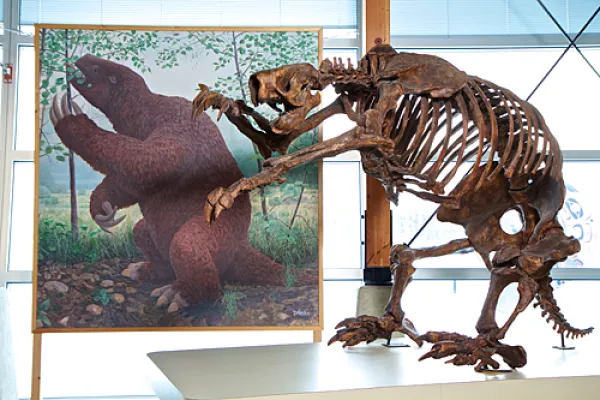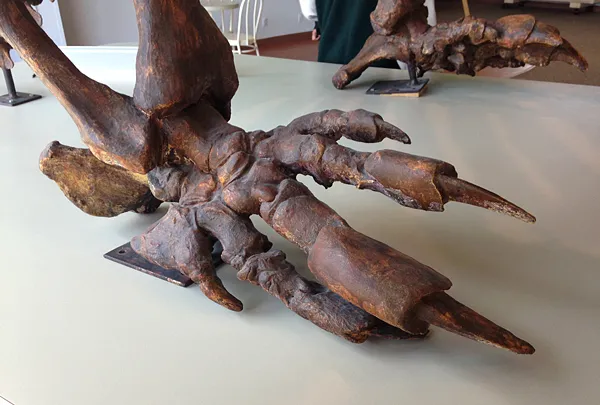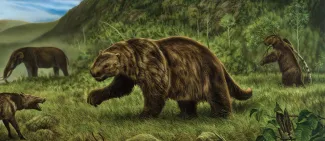The Jefferson's ground sloth might be the strangest creature to ever inhabit Yukon. These unusual animals are distant relatives of the tree sloths that still live in Central and South America today. The sloth family originated in South America and migrated northward across the Isthmus of Panama some five million years ago. Several species of ground sloth lived in North and South America during the Ice Age, but only the one named after former U.S. President Thomas Jefferson made it all the way to Yukon and Alaska.
A fully grown Jefferson's ground sloth was about the size of an ox, at up to three metres long. Although the appearance of these giant ground sloths might seem menacing, they were herbivores. They may have used their long sharp claws in defence, but these claws were probably better suited to grasping for food in tall tree branches. Their long, blunt, peg-like teeth were used to strip leaves from shrubs and tree branches. Jefferson's ground sloth, like its tree-dwelling relatives, was probably a slow, awkward mover on land, with its feet rotated over so it was walking on its ankles and baby toes.
Jefferson's ground sloth fossils are commonly found in the western United States, the Great Lakes region, and Florida. Jefferson's ground sloths probably used caves for protection from the elements and hungry predators. One of their distant relatives, the Shasta's ground sloth (Nothrotheriops shastensis), is famous for the incredibly thick layers of fossilized dung they left preserved in caves of the American southwest. Another spectacular find from a cave in Tennessee contained an individual Shasta's ground sloth's bones that were still attached by ligaments and cartilage. There was even a mummified fingernail on the sloth's finger!
There is still considerable scientific debate on what caused the extinction of these ground sloths around 11,000 years ago. Only a single site discovered in North America has yielded Jefferson's ground sloth bones that appear to have been butchered by humans, so it is unlikely their demise was caused by overhunting.
Yukon's Ground Sloths
In Yukon, Jefferson's ground sloth fossils are rare and only known from sites along the Old Crow River. Other northern specimens have been found near Fairbanks, Alaska and near Yellowknife, Northwest Territories. The Old Crow specimens are significantly smaller than fossils of this species found further south. Their size may have been an adaptation to the colder temperatures faced by Jefferson's ground sloths in the North.
Based on their diet of leafy and woody material, scientists believe Jefferson's ground sloths only lived in the North during the warm interglacial periods. Their habitat preferences suggest they were gone from Yukon by about 75,000 years ago, when cold glacial climates eliminated the trees and allowed the cold, dry Mammoth Steppe to spread. Like mastodons and giant beavers, Jefferson's ground sloths only ventured north to Yukon when brief periods of warm climates appeared during the Ice Age.
Want to know more? Check out the Beringian Research Notes on the ground sloth.
When paleontologists in Yukon discover a large, strange looking fossil that does not fit with the more typical ice age mammals, their first guess is that it is a bone from an ancient ground sloth.



